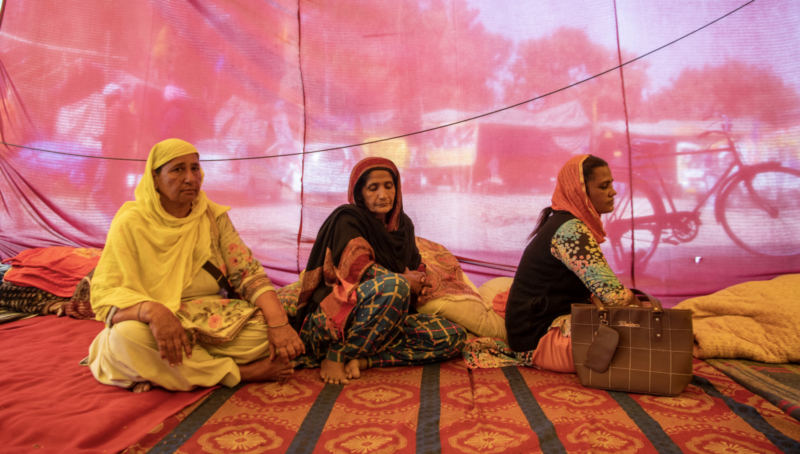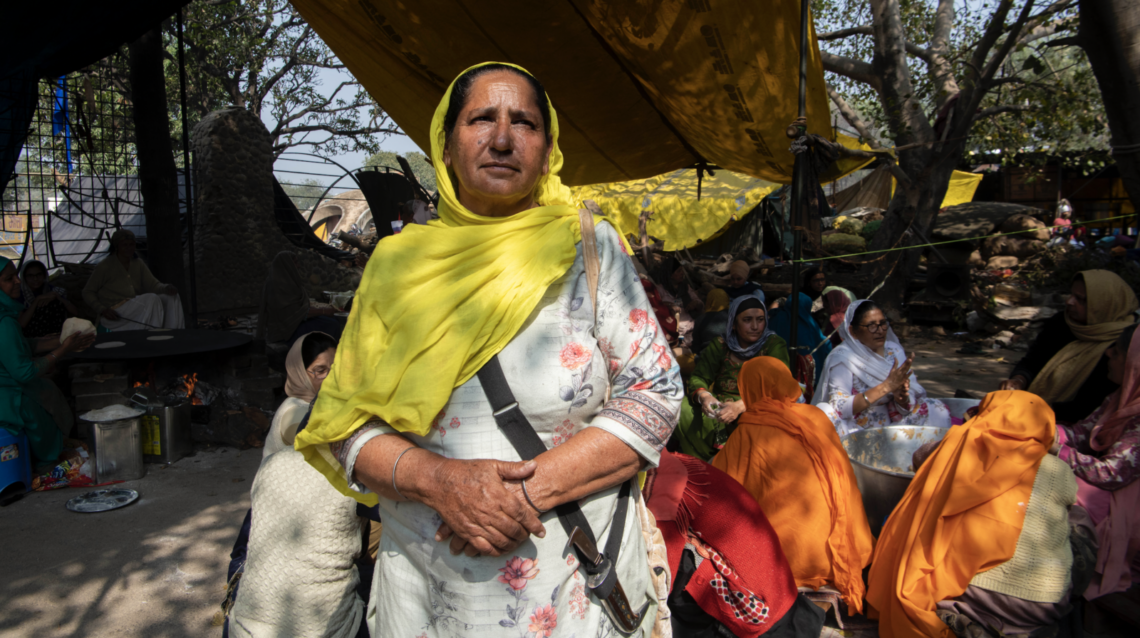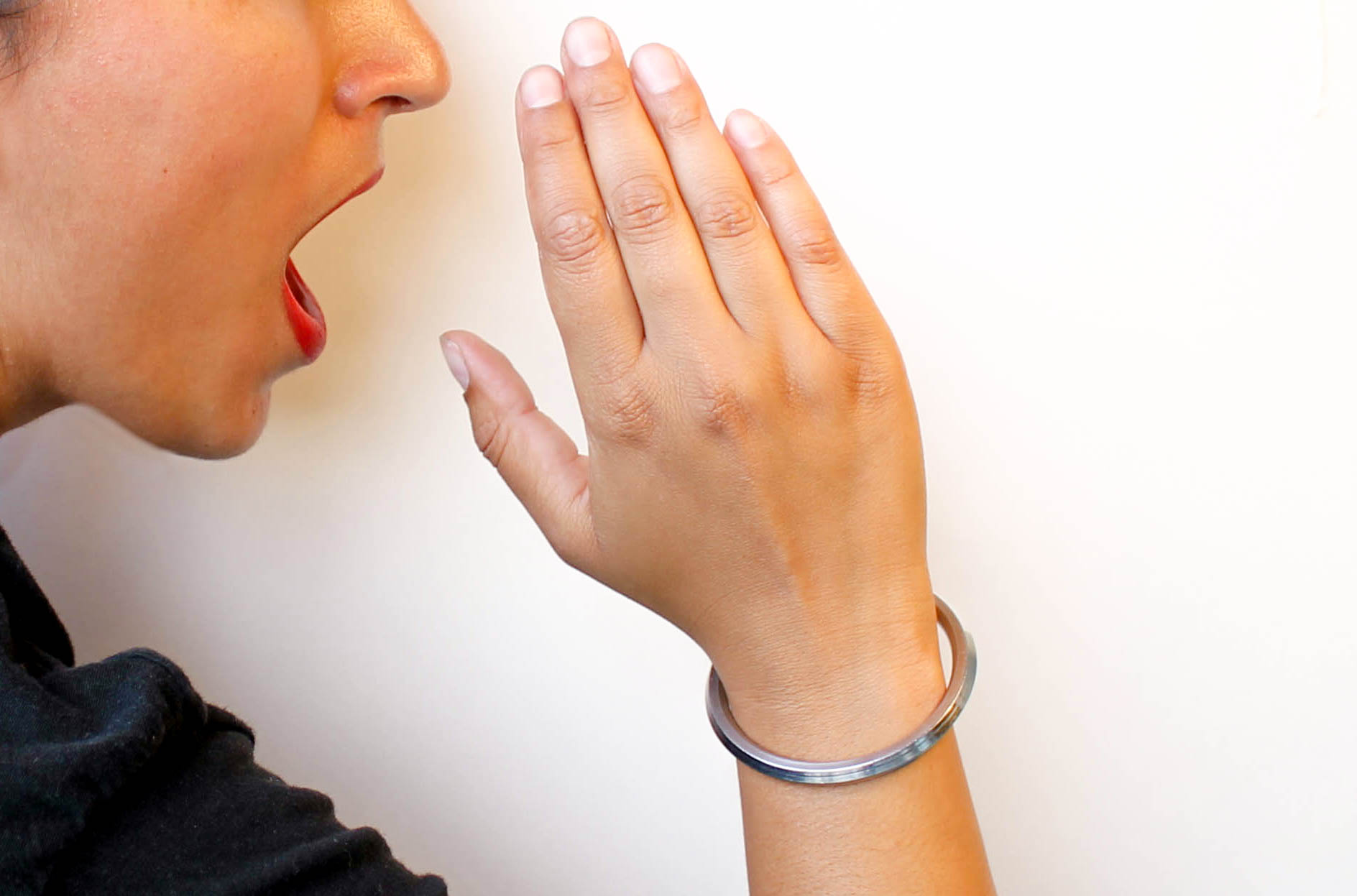Photos and story by Rohit Lohia
Written March 13 – prior to the Punjab internet shut down and warrant for Amritpal Singh.
“How did you learn about this morcha?” I ask.
She replies, “Our kids are behind bars. Why do we need some news platform to know that? It’s pain. It’s mourning, for us.”
A woman wearing a flowery, cream suit with a yellow dupatta in her 60s replied to my question about her presence at the protest site. Sitting around the big cooking pan and rolling rotis for the hundreds of people who have joined the Quami Insaf Morcha (Sikh Nation Justice Protest) which has been going on the borders of Mohali-Chandigarh for the past 2 months.
The Qaumi Insaaf Morcha started in Punjab, India on January 7, 2023 with various Sikh organizations protesting for the release of Bandi Singhs – Sikh prisoners still in jail who have completed their sentences.
Protestors started at the historical Guru Gobind Sahib Gurdwara in Mohali, Punjab and marched towards Chandigarh. However they were stopped at the Chandigarh-Mohali border at the Dolphin Chowk near Yadavindra Public School, one of the main arterial roads from Chandigarh to Punjab. Once a march then became a pakka morcha (sit-in/semi-permanent protest). Based on the model of the Farmers Protest back in 2020-21, Singhs and Kaurs have set up makeshift tents, parked trolleys laden with rations, and established langar. The site has become home for many.
Not Hardeep Kaur’s First Protest
As the woman in yellow instructs another woman on cooking roti, she continues, “These are our kids who are inside prisons. Beant1 was a butcher who caused mass destruction. What our fighters did, they sacrificed for us. We are gonna be here first and foremost. Beant killed children of Punjab, causing mass destruction in the state. Killing him was not a crime, it was an action for humanity.”
1Beant Singh was a former Chief Minister of Punjab during whose tenure upwards of twenty-five thousand of Sikh civilians disappeared or were killed by the police in extrajudicial executions. Several Singhs were charged for his murder.
Hardeep Kaur (Tarn Taran,Punjab) has been staying at the morcha site since the first day and oversees langar for the hundreds of protestors who join the morcha every day. Hardeep adds, “I am a native of the Majha Region. I joined this morcha from the first day. They [the government] have imprisoned our children for decades now. The utmost sickening part is how they have let go of the repulsive Ram Rahim2 and culprits like him. But our people, who just stood against injustice and atrocities, are still inside?”
2Ram Rahim was convicted of rape and murder was released in the middle of his sentence.
As she walks to instruct another woman on cooking rotis, I notice she has difficulty walking. I couldn’t resist asking about it. She says, “It’s nothing. I just hurt it while working here while I was walking from the main tent to the langar area one early morning. But it feels like nothing; our Gurus were slaughtered and their children were murdered. But did they show reluctance to stand against the wrong? No. Mine are just small pains.”
This is not Hardeep’s first protest. In fact, she is a seasoned protestor. She was at the 2020-21 Farmer’s Protest: “I lived for a month at Tikri Border protest site at New Delhi and 5 months at Singhu Border protest site. Now, I have been here since the 7th of January. My son has joined the farmers group at this protest.”
Kaur’s children, three sons and a daughter, are all grown and married so, she finds herself with more time to protest and stand against atrocities. She says, “It’s our children who are in the police and it’s our children who are in the army. But today we are standing against each other. It’s like anarchy, where mother and son are killing each other.”
Seeing the spark in her eyes and the zeal in her voice, I couldn’t resist asking her if the Farmers Protest was her first protest. Kaur says “no”, “[In the 1980s] I also used to attend the protests during Sant Jarnail Singh’s3 time. I was a kid back then and didn’t know much but still used to attend. That taught me what coming together as a community meant. Now I am free from my children, they are married and settled, so I attend protests now wherever it happens.”
3Baba Jarnail Singh Bhindranwale was a prominent Sikh activist & shaheed (martyr).
Crossing her legs, handing over her job of making roti to another woman, she turns towards me and continues, “What the Bandhi Singhs (Sikh prisoners) did was correct. Beant Singh got what he deserved, and so did Gobind Ram4 and Indira Gandhi5. We didn’t even forgive General Dwyer6 and gave him what he deserved on foreign soil. Yet, today’s leaders think they will get away with anything?”
4Gobind Ram was the Senior Superintendent of Police in the 1980s. During his tenure he led a crackdown on Sikh activists and separatists. There are 31 documented cases directly implicating Gobind Ram in abduction and disappearance. On January 8, 1990, Sikh seperatist organizations,, Khalistan Liberation Force and the Babbar Khalsa, killed Gobind Ram in a bomb blast.
5Indira Gandhi was the Prime Minister of India from 1980 to 1984. She spearheaded the 1984 attack on Harmindar Sahib and the anti-Sikh pogroms. She was assassinated by her Sikh bodyguards, Shahhed Satwant Singh and Shaheed Beant Singh, as an act of justice.
6General Michael O’Dwyer was the Lieutenant-Governor of Punjab at the time of the 1919 Jalianwala Bagh Massacre. He was believed to have been the main planner and approved R.E.H. Dyer’s action of opening fire on a peaceful gathering, killing over 1000 people. In 1940 Udham Singh shot and Killed O’Dwyer for his role in the massacre.
The decades following the 1980s mark the darkest period of Sikh history in modern times. “It was the beginning of a policy of gross human rights violations in Punjab that continues to have profound implications for the rule of law in India,” reports Ensaaf. During this time, thousands of Sikhs were killed, disappeared, assaulted, tortured, and attacked.
Hardeep reminds me about the era as her voice dims, “I haven’t forgotten the 1984 episode yet, I still remember each day of that time. The ones in power are destined to go to hell, but on this ground, we will fight and not back out.”
Early Morning Starts
Hardeep’s morning starts early before sunrise, “I wake up at 5, take a bath and after offering prayer to Guru Sahib. I clean the langar area, light the big stove, and prepare tea for myself and others.”
Hardeep, who has been overseeing the langar arrangements since the first day, continues, “After having my tea and preparing for the morning meal. I head back to the main tent where I clean the area and sit for some time to wait for people from all over to join the morcha.”
The food preparations begin around 11:00 am in the morning, which keeps her occupied until the evening. “I am a mother of three sons and a daughter. All my sons are married and have kids. That has taught me what it means to be a mother and helps me serve here.”
A farmer and a mother, Hardeep was undeterred by the incident of confrontation with authorities in February or by the heavy presence of paramilitaries which has surrounded the morcha.
While mostly a peaceful movement, the protest has seen a couple of confrontations with the authorities. On January 18, some protesters attacked the vehicle of SGPC Chief Harjinder Singh Dhami when he visited the dharna site. On February 8, a group of protesters and Nihangs clashed with police when they tried to enter Chandigarh to hold a demonstration outside Punjab Chief Minister Bhagwant Mann’s residence.
Hardeep says, “My hope is nothing less than to see the Bandhi Singhs taking a breath in the free air and to hold responsible the culprits of sacrilege in recent years. The movement has been set up to free the political prisoners held responsible for the killing of former Punjab CM Beant Singh and also to demand the arrests of people accountable for the sacrilege of Guru Granth Sahib.”
Adjusting her dupatta, she continues, “We are here. These deployed uniform men are ours only. They are not from Pakistan or some other nation. We will fight with them if need be and will reach the goal we are here for. We will answer sticks with sticks, whatever they do we will return with the same thing. We are not sitting here unarmed, they might try to come whenever they want to.”
Since the confrontation, the Punjab Police have beefed up the security and surveillance at the protest site, bringing horses, tents, and heavy equipment. 6 bulletproof vehicles that are usually deployed at India-Pakistan borders are now stationed at the dividing roads of sector 52/53 Mohali. Each vehicle has the capacity of 5 sharpshooters.
She says, “We don’t inflict fear or take it either. We don’t inflict terror or take it either. They can bring any number of weapons or bullet-proof tractors or cars or anything. We are ready for anything and everything.”
The woman sitting beside her tries to add something to the conversation, “My Akal Purkh provides me with the strength to carry on. I am an Amritdhari Sikh, and our Guru’s Immortal Nectar guides me to stand against the ones we vote into power. Bhagwant Mann who is CM of Punjab has done nothing but practice divisive politics, creating division among the communities in Punjab. Sidhu Moosewala, Son of Punjab was shot dead at pointblank. But did that affect CM Mann in any manner? Did he even once come to talk with us?”
Kaur points towards the entry of the morcha, where Nihangs have set up their camps in the frontline, just like the farmer’s movement. Hardeep continues, “He does a lot of drama, he does a lot of show. But come here to the morcha, speak with us once. We are not here to kill or harm him.”
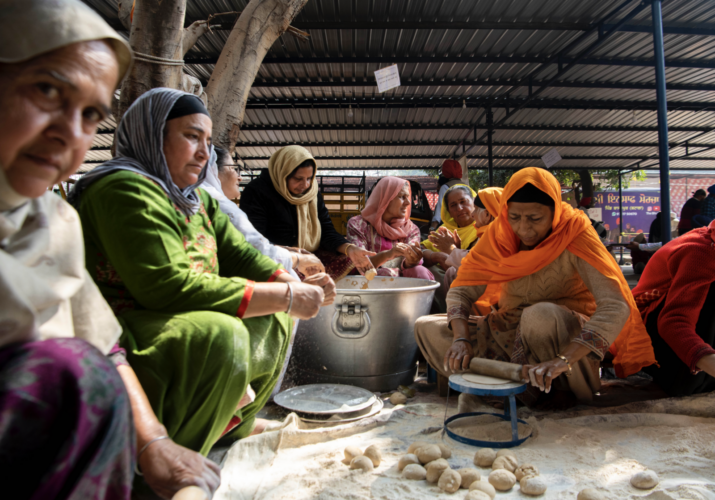
Women’s Role in Protesting
I see a huge number of women in the langar area but finding them absent on stage. When asked what being a woman and sitting on the roads means for her, she says, “So what I am a woman? I am a human first like any other.”
With all her courage and zeal to fight, I ask how important she feels the role of women in leadership and more importantly, their absence in prestigious matters. Looking straight into my eyes, she says, “Women don’t want to take charge, which saddens me. If they want, they can and they must. We are no less than any man here. Now our children are getting educated, they are getting academic degrees, they are gonna be our next generation who is gonna take charge. They will bring the change I have been waiting as a woman.”
Opening her arms and pointing towards dozens of women around her, Kaur adds, “Women are going at the front row. Take the example of the February incident, women fought with men shoulder by shoulder and taught the cops a lesson. Also, the men here are protesting because to us. Empty stomachs don’t bring a revolution.”
She stand from the langar area and heads towards the main tent which has also become her temporary home. I ask her if I could join. Walking with her we cross the scores of protestors having their meal, sitting in a row. We pass the vendors selling posters, clothes to cover heads, portraits of Sant Jarnail Singh, Sidhu Moosewala, and Deep Sidhu along with others, and lockets and pendants with engraved Sikh emblems. She takes a locket of Guru Gobind Singh in her hand, turns towards me and says, “When Kashmiri Pandits came to our Guru Tegh Bahadur Ji for help, Guru Gobind Singh Ji was around seven and half years old. He asks his father, Guru Tegh Bahadur, about the matter. After learning about the danger to their lives and their religion by Aurangjeb, he asks and convinces Guru Tegh Bahadur Ji to help the pandits saying, “Even if my mother becomes a widow or I become a fatherless son, thousands of women and children will be saved.” Then Guru Tegh Bahadur Ji sacrificed himself in Delhi.
This is our story, this is us, this is our history. We can’t back out from who we are. We are here to sacrifice our heads here.
Just like we are being oppressed, our Bandhi Singhs sacrificed themselves for the greater good of the community.”
We reach the main tent which has been divided in two to sit and sleep protestors. There is a center path to reach the main stage which has serves as a gurdwara. Kaur shows me the whole area and says, “On one side women sleep and on the other men. Around 300 women sleep here at night.”
As she reaches her station, she hugs women sitting in the area. She introduces us and requests us to sit. Pointing at the women around her, Hardeep says, “This has become like a family. I have found many friends, they are like my sisters. We sit and discuss our lives when taking a rest.”
While women have found solace in each other, men have established the camps and tractors outside the main tent where they are guarding the site. The road was covered with yellow flags of Nishan Saheb with posters of Bandhi Singhs, Sant Jarnail Singh, Sidhu Moosewala, and Deep Sidhu along with many children of Punjab who were killed fighting for the community.
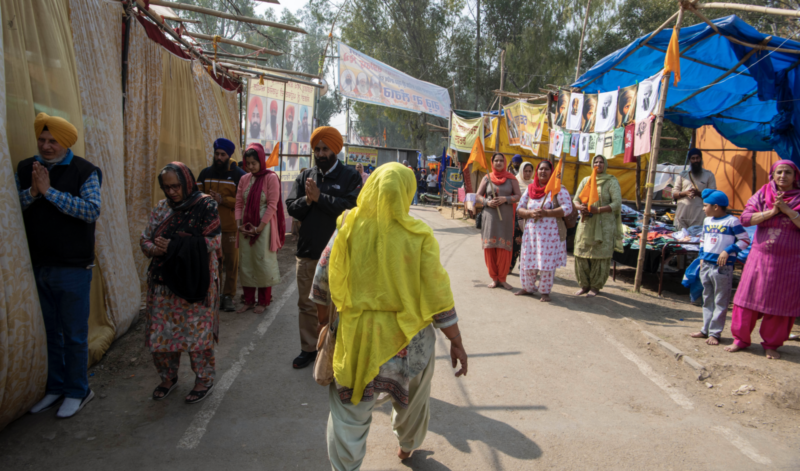
“Raise Your Voice”
Before taking my leave, I ask Hardeep how does she feel people from the Sikh community residing outside India can contribute to the protest. She says, “The Sikhs settled or studying outside India also know their roots. My appeal to them is not to forget our freedom fighters, our Bandhi Singhs, and not to forget the sacrilege attempts we have faced. I appeal to them to raise their voices in their respective nations, request foreign governments to host talks with PM Modi.”
I ask Hardeep if she feels confident that the movement will be successful, and she reminds me of the Farmer Protest saying, “Don’t forget we brought PM Modi, a Hindu Nationalist leader to his knees and he had to repeal farm laws.”
Raising her hands to the slogan from the stage, she chants, “Raj Karega Khalsa!” and “Jo bole so Nihal – Sat Sri Akal!”
She continues talking about her future plans, “My bags are always packed. We will win this and then continue the fight against other atrocities in Punjab.”
